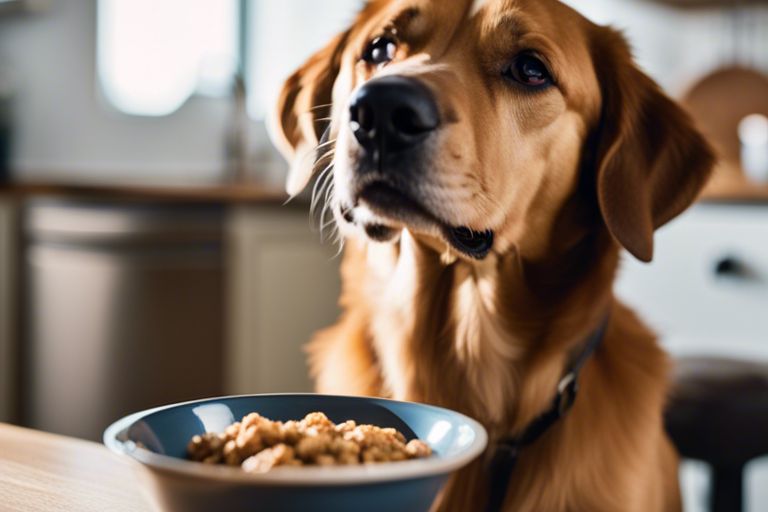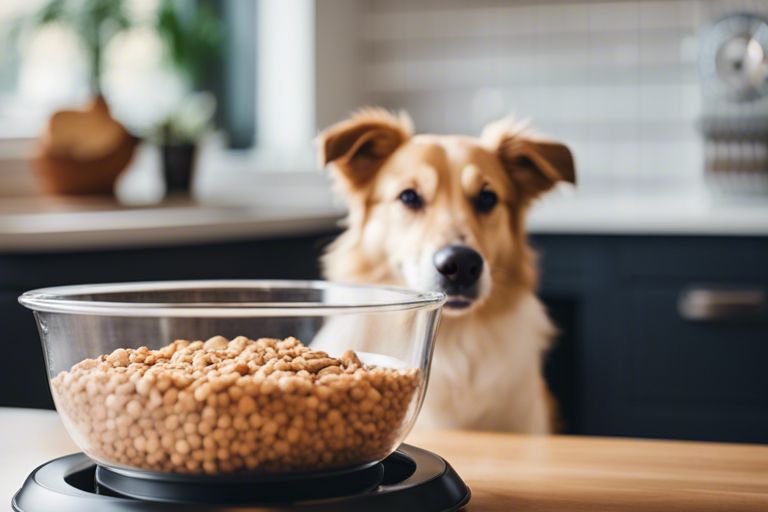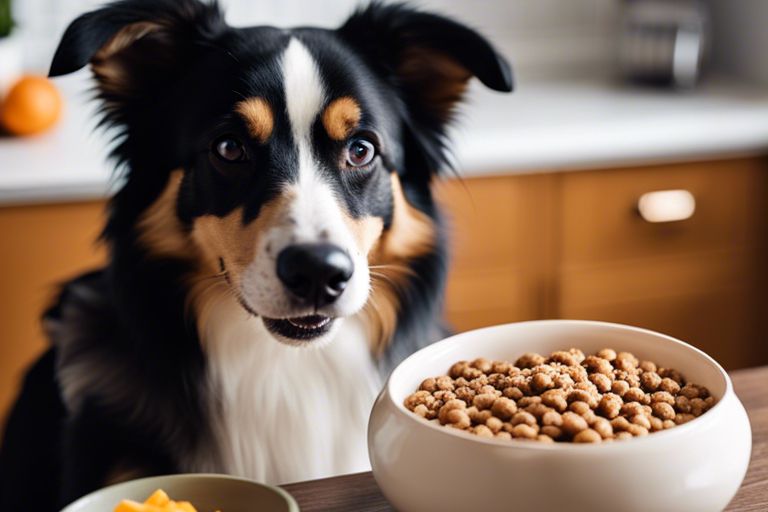Evening brings a time-honored question for pet owners: When is the best time to feed our canine companions? As we research into the intricate world of canine nutrition, we uncover the optimal feeding schedule for our loyal friends. Join us on this enlightening journey as we explore the ideal timing to nourish our beloved furry family members.
Key Takeaways:
- Morning is ideal: The best time to feed a dog is in the morning because it aligns with their natural feeding cycle.
- Consistency is key: Establish a regular feeding schedule to regulate your dog’s digestion and prevent overeating.
- Avoid feeding late at night: Give your dog ample time to digest their meal before bedtime to prevent discomfort or issues like bloating.
- Consider activity levels: Adjust feeding times based on your dog’s activity level – more active dogs may benefit from smaller meals throughout the day.
- Consult your vet: Your veterinarian can provide personalized advice on the best feeding schedule for your dog based on their breed, age, and health needs.
The Importance of Timing
Why Feeding Time Matters
With regards to feeding your furry friend, the timing of their meals plays a crucial role in their overall health and well-being. Dogs, like many animals, thrive on routine and consistency. Establishing a regular feeding schedule can help regulate their digestion, maintain a healthy weight, and even improve their behavior.
Furthermore, feeding your dog at the same times each day can also help in training and prevent food-related aggression. By sticking to a consistent schedule, you are providing structure and stability for your canine companion, which can lead to a happier and more obedient pet.
The Consequences of Poor Timing
Timing is of the essence when it comes to feeding your dog. Inconsistent meal times or irregular feeding schedules can have negative consequences on your pet’s health. If a dog is not fed at the right times, it can lead to digestive issues, such as bloating or constipation. Moreover, erratic feeding times can also disrupt their metabolism and energy levels, impacting their overall vitality.
Timing is crucial for ensuring your dog’s well-being. Poor timing in feeding can not only affect their physical health but also their emotional state. Dogs thrive on routine, and a disrupted feeding schedule can cause anxiety and stress in your furry companion.
A Dog’s Natural Instincts
Some of a dog’s behaviors and preferences can be traced back to their natural instincts as descendants of wolves. Understanding these instincts can help us determine the best time to feed our furry friends.
The Hunting Instinct
One of the key instincts in dogs is their hunting instinct. Dogs are natural hunters, and their ancestors would spend hours tracking and hunting for prey. This instinct is why many dogs enjoy interactive toys and games that stimulate their hunting instincts. Feeding your dog at a time when they would naturally be hunting for food can satisfy this instinct and make mealtime more enjoyable for them.
The Pack Mentality
Instincts drive dogs to be pack animals, with a clear hierarchy and social structure. In the wild, wolves would hunt together and share their food within the pack. This pack mentality influences a dog’s behavior at mealtime, as they may prefer to eat when their human or canine family members are also eating. This can be a comforting and social experience for a dog, reflecting their instinctual behavior in a pack setting.
To cater to your dog’s pack mentality, consider feeding them at a time when the family is gathered together, such as during your own meal times. This can help create a sense of togetherness and security for your furry companion, aligning with their natural instincts as pack animals.
Factors Affecting Feeding Time
Unlike us, dogs have different factors that determine the best time for feeding. These factors can vary from their age and life stage to their breed and size. Perceiving these factors can help you establish a feeding routine that is beneficial for your furry companion. For more information on feeding times and frequency for your dog, you can visit Feeding Times and Frequency for Your Dog.
Age and Life Stage
To ensure that your dog receives the appropriate nutrition, it’s necessary to consider their age and life stage when determining the best time to feed them. Puppies, for example, may require more frequent meals throughout the day to support their growth and development. On the other hand, adult dogs may thrive on a consistent feeding schedule that aligns with their energy levels and daily activities.
Breed and Size
Size plays a significant role in a dog’s feeding schedule as larger breeds may have different nutritional requirements than smaller ones. Additionally, certain breeds may be more prone to obesity or digestive issues, influencing when and how much they should be fed. Understanding your dog’s breed and size can help you tailor their feeding time to promote their overall health and well-being.
Time and consistency in feeding can impact your dog’s digestion and weight management. By considering your dog’s specific breed and size, you can create a feeding schedule that caters to their unique needs, ensuring they receive the necessary nutrients without overeating.
Health Conditions and Medications
Conditions such as diabetes or food allergies can affect when and what your dog should eat. Some medications may require your dog to take food at specific times to maximize their effectiveness. It’s crucial to work closely with your veterinarian to establish a feeding routine that complements your dog’s health conditions and medications.
This tailored approach to feeding can help manage your dog’s health conditions and ensure that they receive the necessary nutrients without any adverse effects from their medications. By incorporating these factors into their feeding schedule, you can support your dog’s overall well-being and longevity.
The Role of Circadian Rhythms
Now, let’s examine into the fascinating world of circadian rhythms and their impact on our canine companions. Dogs, like humans, have an internal body clock that regulates various physiological processes, including sleep-wake cycles, hormone production, and metabolism. This internal clock is influenced by environmental cues such as light and temperature, helping to synchronize the body’s functions with the natural rhythms of day and night.
The Body’s Internal Clock
One of the key components of the body’s internal clock is the hormone melatonin, which is produced in response to darkness and helps regulate sleep patterns. By understanding and respecting your dog’s circadian rhythms, you can optimize their feeding schedule to promote better digestion, nutrient absorption, and overall well-being.
Feeding in Sync with Nature
Nature has its own rhythm and dogs, being descendants of wolves, have retained some of their ancestral feeding habits. In the wild, wolves hunt for food during the early morning and late evening, aligning their feeding times with the natural light-dark cycle. By feeding your dog in sync with nature, you can mimic this natural rhythm and potentially improve their digestion and energy levels.
With a little observation and trial and error, you can determine the best feeding times that align with your dog’s natural circadian rhythms. Whether it’s adjusting meal times based on their activity levels throughout the day or offering smaller, more frequent meals during their most active periods, syncing your dog’s feeding schedule with nature can have a positive impact on their health and vitality.
Identifying Your Dog’s Ideal Feeding Time
Not sure about the best time to feed your furry friend? The answer might not be as straightforward as you think. Factors such as your dog’s age, breed, activity level, and individual preferences can all play a role in determining the ideal feeding time. If you only feed your dog once a day, you might be wondering whether morning or evening is better. To dive deeper into this topic, check out this insightful discussion on If you only feed your dog once a day, is morning or evening better.
Observing Hunger Cues
Observing your dog’s hunger cues can be a helpful way to determine the best time to feed them. Some dogs may start to become more vocal or active when they are hungry, while others may exhibit more subtle signs like sniffing around for food or licking their lips. By paying attention to these cues, you can get a sense of when your dog is most eager for a meal.
Monitoring Energy Levels
On top of hunger cues, it’s also important to monitor your dog’s energy levels throughout the day. Just like humans, dogs can experience fluctuations in energy levels based on factors like exercise, playtime, and even the weather. By noting when your dog is most active and playful, you can better align their feeding time with when they will have the most energy to enjoy their meal. Levels of energy can give you a good indicator of when your pup might be most ready to chow down.
Experimenting with Different Schedules
Schedules for feeding can vary greatly depending on your dog’s lifestyle and preferences. Some dogs may thrive on a strict eating schedule, while others may prefer more flexibility. Experimenting with different feeding times and observing how your dog responds can help you pinpoint the ideal schedule for them. Whether it’s feeding your dog once or twice a day, finding the right balance can make a big difference in their overall well-being and satisfaction.
The key to determining the best feeding time for your dog lies in understanding their unique needs and preferences. By observing hunger cues, monitoring energy levels, and experimenting with different schedules, you can tailor your dog’s feeding routine to ensure they are happy, healthy, and well-fed.
Avoiding Common Feeding Mistakes
Overfeeding and Obesity
The key to maintaining your dog’s health and well-being is to avoid overfeeding them. Just like humans, dogs can suffer from obesity, which can lead to a host of health problems such as diabetes, joint issues, and heart disease. It is important to feed your dog the right amount of food based on their age, size, and activity level.
Underfeeding and Malnutrition
The opposite end of the spectrum is underfeeding your dog, which can result in malnutrition and other health concerns. It’s crucial to provide your furry friend with enough nutrients to support their growth and energy needs. Consult with your veterinarian to determine the appropriate portion sizes and the best type of food for your dog’s specific requirements.
On the other hand, be cautious not to give in to those puppy-dog eyes begging for more food, as overfeeding can lead to excessive weight gain and related health issues.
Irregular Feeding Schedules
Irregular feeding schedules can disrupt your dog’s digestive system and overall routine. Dogs thrive on consistency, so establishing a regular feeding schedule is key to their well-being. Aim to feed your dog at the same times each day to regulate their metabolism and prevent potential issues like bloating or stomach upset.
Irregular mealtimes can also lead to behavioral problems, as dogs may become anxious or frustrated when they are unsure of when their next meal will be. By sticking to a consistent feeding schedule, you are providing your dog with a sense of security and routine that promotes their overall health and happiness.
Avoiding these common feeding mistakes will help you keep your dog healthy, happy, and thriving for years to come. By being mindful of their dietary needs and establishing a routine that works for both of you, you can ensure that your furry companion receives the best care possible.
To wrap up
Following this exploration of when to feed a dog, it is clear that there is no one-size-fits-all answer. The best time to feed your furry companion may depend on various factors such as their age, breed, activity level, and individual preferences. It is vital to observe your dog’s behavior and consult with a veterinarian to determine a feeding schedule that best suits their needs.
Bear in mind, just like us, dogs thrive on routine and consistency. By providing them with nutritious meals at regular intervals, you can help support their overall health and well-being. Ultimately, the best time to feed your dog is when it works best for both of you and fits into your daily routine seamlessly.
FAQ
Q: When is the best time to feed a dog?
A: The best time to feed a dog is in the morning and evening, as it aligns with their natural feeding habits. It’s important to establish a consistent feeding schedule to help maintain their health and well-being.
Q: How many meals should I feed my dog each day?
A: It is recommended to feed adult dogs two meals a day, one in the morning and one in the evening. Puppies, on the other hand, may require more frequent feeding, typically 3-4 meals a day, as they have higher energy needs.
Q: What time should I avoid feeding my dog?
A: It is best to avoid feeding your dog right before or after vigorous exercise, as it can lead to digestive issues. Allow some time for your dog to rest before or after meals to prevent any discomfort.
Q: Should I feed my dog at the same time every day?
A: Yes, it’s beneficial to feed your dog at the same times every day to establish a routine. Dogs thrive on routine and consistency, so a regular feeding schedule can help them feel secure and maintain a healthy appetite.
Q: Can I feed my dog snacks or treats between meals?
A: It’s okay to give your dog snacks or treats between meals, but be mindful of the portion size and calorie content. Too many snacks can lead to weight gain and nutritional imbalances, so it’s important to offer treats in moderation.



